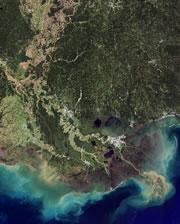 The controversial Three Gorges Dam in China is planned to be the largest hydroelectric dam in the world.© SPL
The controversial Three Gorges Dam in China is planned to be the largest hydroelectric dam in the world.© SPLHumans have interfered with more than half of the world's large rivers by building dams, a new survey reports. This first worldwide assessment highlights the ubiquity of these structures and their impact on water flow and soil erosion, say the authors.
The survey was led by landscape ecologist Christer Nilsson at Umeå University in Sweden. He and his colleagues quizzed hundreds of local authorities and researchers across the world to compile information on how much water their rivers carry and how many dams they have.
Nilsson's interest in cataloguing the impact of dams began in the late 1980s, when an intense debate formed in Sweden over plans to dam the country's remaining free-flowing rivers for hydropower. He says that proponents of the project told him not to worry about the environmental impact because most rivers elsewhere in the world remained untouched.
“This study is the first that shows the whole picture.”
Christer Nilsson
Umeå University
"I didn't believe them, so I started looking around, but there were no summarized data," he recalls. "This is the first study that shows the full picture."
His team has now identified 292 large river systems, of which 172 are counted as affected by dams. In Europe, more than 60% of these rivers were classified as 'strongly affected', meaning that the constructions alter the flow by at least 2%. Australasia - encompassing Australia, New Zealand and neighbouring islands in the South Pacific - has the smallest proportion of strongly affected large rivers, at only 17%. The findings appear this week in the journal Science1.
Current change
 Experts fear that dams are preventing sediments from flowing to the mouths of rivers such as the Mississippi.© James P.M. Syvitski]
Experts fear that dams are preventing sediments from flowing to the mouths of rivers such as the Mississippi.© James P.M. Syvitski]In another study in Science this week, researchers led by James Syvitski of the University of Colorado, Boulder, show that dams prevent significant amounts of sediment from reaching coastlines2. Without this replenishment, the regions around river mouths can experience severe soil erosion.
Nilsson says that his survey highlights the global nature of the damming problem and notes that most new dams are being planned for Asia and South America. Engineers in Southeast Asia, for example, plan to add 49 more dams to the Chang Jiang (Yangtze) river, already home to China's controversial Three Gorges Dam. Nilsson hopes that his survey will influence decision-making on the planned construction.
ADVERTISEMENT
"When people see the global picture they will act differently," Nilsson says. He adds that his study has intensified his own doubts about dam projects: "My concern has increased because I see that there are no pristine areas in terms of unimpeded rivers."
The broad scope of the new report makes it valuable, says Mike Dunbar, a researcher at the Centre for Ecology and Hydrology in Wallingford, UK. He says that the data will serve as a "wake-up call" for people who plan to dam those rivers that remain free-flowing.
Umeå University
